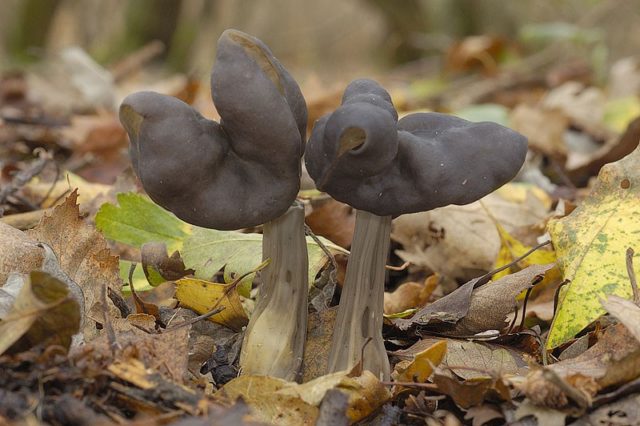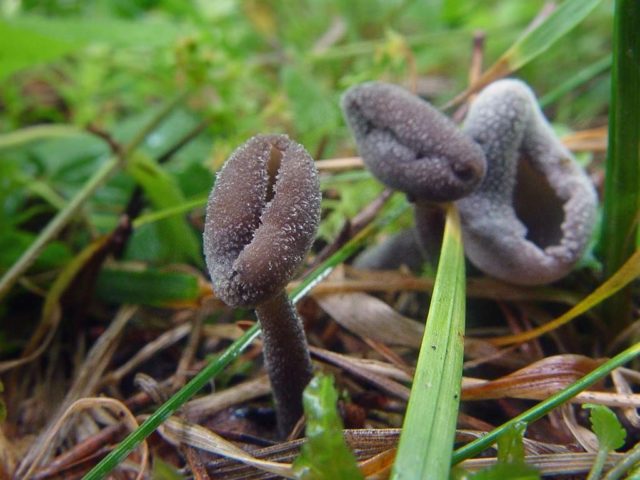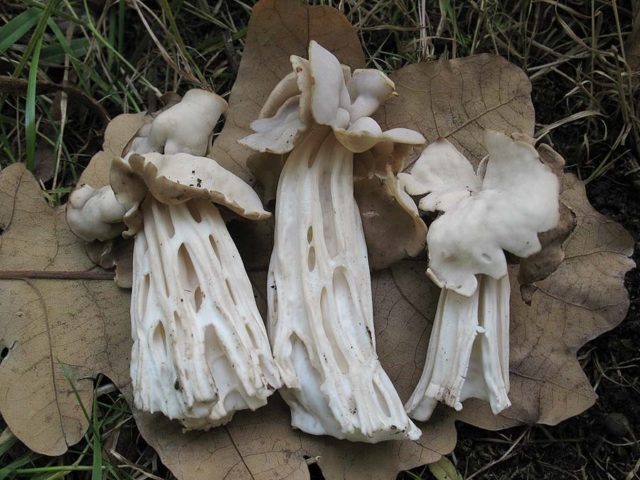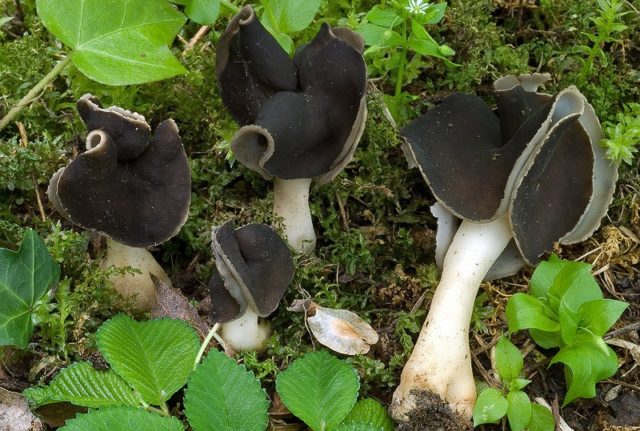Content
Lobules are a rare marsupial mushroom of the Helwell family, the Helwell genus. Has an unusual appearance. Another name is furrowed helwell. Spores are found in a "bag" in the fruiting body.
What do the pitted blades look like
The mushroom consists of a stem and a cap, as if folded in half or crumpled. Because of this, it takes on an irregular or saddle shape, forming a kind of horns. It has two or three lobes, the size is from 2 to 4 cm in width, from 1 to 5 cm in length. The edge is freely located, sometimes grows to the stem, torn in older specimens. The upper surface is smooth or slightly wrinkled, in color from gray to black, the lower one is lighter, usually grayish.
The length of the leg is up to 6 cm, the thickness is from 1 to 1.5 cm. It is often curved, widening downward, folded, ribbed, usually gray in color, becomes darker with age.
Spores with smooth walls, elliptical, colorless or white, with oil droplets. Size - 15-17 X 8-12 microns.
The flesh of the lobe pitted is thin, very fragile, grayish in color, with no pronounced mushroom odor.

Helwella pitted is unattractive for mushroom pickers because of its appearance
Where do the pitted lobes grow
Grows in deciduous forests next to birches, less often in coniferous stands. Possibly forms mycorrhiza with birch. Occurs in small groups or singly, often in fairly open areas. It settles on moist and alkaline soils and litter, loves old fireplaces and forest fires. Distributed throughout Eurasia, but infrequently. Fruiting in summer and autumn.
Is it possible to eat pitted lobes
Refers to conditionally edible.
False doubles
Long-legged lobe... An inedible mushroom with a goblet or saddle cap flattened at the sides. The outer surface is bumpy, gray or with a purple tint. The inner part is lighter, white and beige. The stem can be smooth or bumpy, narrower in the upper part, the color is similar to the inner surface of the cap. The pulp is odorless and tasteless, thin, watery. Fruiting from June to early October. Prefers moist forests, can settle on moss and rotten wood residues, grows in groups.

Long-legged gelwell is easy to distinguish by the shape of the cap and the color of the fruiting body
Curly loafer... Not very common conditionally edible mushroom of the Gelwell family with low taste. Some sources suggest that it be considered inedible. The main difference from the pitted is the lighter color. The cap is irregular in shape, consists of 2-4 blades. The edges are curly or wavy, hanging freely or in some places growing to the stem. Color from white and waxy beige to yellow and light ocher. The leg is straight or curved, short, swollen at the base, hollow. Surface with deep folds or grooves.The color is whitish or ash gray. The pulp is fragile, thin, waxy white, with a pleasant mushroom aroma. Fruiting from early August to October.

Helwella curly differs from pitted in white
White-legged lobe... Conditionally edible with a saddle-shaped or curved cap, consisting of three or more lobes. The surface is grayish-brownish or blackish, smooth, sometimes with lighter spots. The villi can be seen on the underside. Stem is hollow, white, widened at the base or flattened, smooth, without grooves, dirty yellow or smoky brown in old specimen. The pulp is fragile, thin, taste and smell are not expressed. Grows in groups, in coniferous and deciduous forests, on sandy soils. Fruiting from May to October. In some sources there is information about the toxicity in its raw form and the need for prolonged heat treatment.

Helwella white-footed is distinguished by a white smooth leg without grooves
Collection rules
When collecting, it is recommended not to pull out the mushroom, but carefully unscrew the leg so as not to damage the mycelium. You can only cut off the caps.
Use
It is rarely eaten due to its strange appearance. In addition, its taste is low. It is allowed to eat this mushroom only after thorough soaking (within 24 hours), washing and boiling. Only after that you can start cooking the mushroom, be sure to drain the broth. Lobules can be fried.
Conclusion
Pit-lobe has an unattractive appearance, therefore it is practically not used for food and is of no value to mushroom pickers. From a distance, the furrowed helwell resembles a burnt piece of wood left after a fire. It is completely unappetizing and there is no desire to rip it off.








